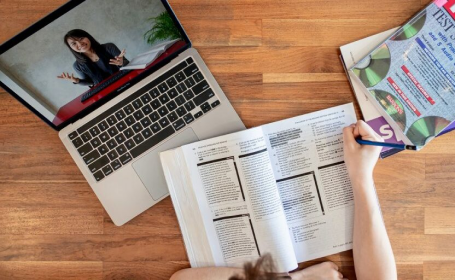he TOEFL exam evaluates your ability to read, listen, speak, and write in English. These are the 4 fundamental skills that decide how proficient you are in a language. As a result, the TOEFL exam is broken down into 4 sections:

Reading

Listening

Speaking

Writing
The structure of these sections has changed over the years and the information below is for the newest version of the TOEFL exam (starting July 26, 2023).
In the reading section of the exam

you will be given 35 minutes to read 2 different reading passages and answer questions related to those passages (10 questions for each passage). Overall, you will have 35 minutes to answer 20 questions. The questions are mostly multiple choice questions
In the listening section of the exam
you will listen to conversations (often between a student and a professor) and lectures, and then answer questions related to those conversations/lectures. Usually, there will be 2 conversations and 3 lectures. You can listen to each conversation and lecture only once (so you need to take notes). Overall, you will have 36 minutes to answer 28 questions (5 questions for each conversation and 6 questions for each lecture). The questions are mostly multiple choice questions.

In the speaking section, you will be given 4 tasks

During the first task (also called the independent task) you will be given a question or statement related to a familiar/general topic. You will then be asked to provide your opinion on that statement and support your opinion with reasons and examples. You are given 15 seconds to prepare your answer and 45 seconds to speak.
For example, the reading passage may be about a new policy that bans the parking of bicycles in certain parts of a university campus. The listening passage might be about 2 students discussing the new policy and how it will affect them. They may be angry about the policy because it is going to cause certain problems for them. In your response, you would have to present the main idea of the reading passage, then talk about how the students feel about it, why it’s a problem, and what they are planning on doing about it.

For example, the reading passage may be about a new policy that bans the parking of bicycles in certain parts of a university campus. The listening passage might be about 2 students discussing the new policy and how it will affect them. They may be angry about the policy because it is going to cause certain problems for them. In your response, you would have to present the main idea of the reading passage, then talk about how the students feel about it, why it’s a problem, and what they are planning on doing about it.

In the third task you will be given a reading passage, which disappears after 45-50 seconds (you need to take notes during this time). You will then listen to a lecture that is related to the reading passage. You need to combine the information from the reading and listening passages in your response. You should present the main points of the reading passage, then summarize how the information in the listening passage adds to the reading passage. You will have 30 seconds to prepare and 60 seconds to answer.
For example, the reading passage may be about a certain scientific theory. The listening passage might be a lecture that presents certain examples of that theory or provides further evidence of that theory. In your response, you would have to summarize the theory presented in the reading passage, then talk about the examples/evidence that further support that theory.
In the fourth task you will listen to a lecture and then you will be asked to summarize the main points presented in that lecture. You will have 20 seconds to prepare and 60 seconds to answer.

In the writing section of the exam you will be given 2 tasks:

The first writing task (“integrated writing”) is very similar to the third task given in the speaking section – you need to read a passage then listen to a lecture related to the reading passage. You are then given 20 minutes to write a short essay combining the information from the reading and listening passages. Unlike the third speaking task, the reading passage comes back after you listen to the listening passage, so you can read the passage while you write your essay.
The second writing task (this is a new task) is called “Writing for an Academic Discussion”. Here you will be asked to contribute to an online discussion. You will see a statement/question by a professor, and the opinions of 2 students who have responded to that question/ statement.
You need to write your own response by stating your opinion and providing reasons and examples to support your opinion. Your response should also add to the conversation by making references to the opinions of the students who had already responded, adding to their ideas, disagreeing with them, etc. You will have 10 minutes for this task.

For example, the reading passage may be about a new policy that bans the parking of bicycles in certain parts of a university campus. The listening passage might be about 2 students discussing the new policy and how it will affect them. They may be angry about the policy because it is going to cause certain problems for them. In your response, you would have to present the main idea of the reading passage, then talk about how the students feel about it, why it’s a problem, and what they are planning on doing about it.
